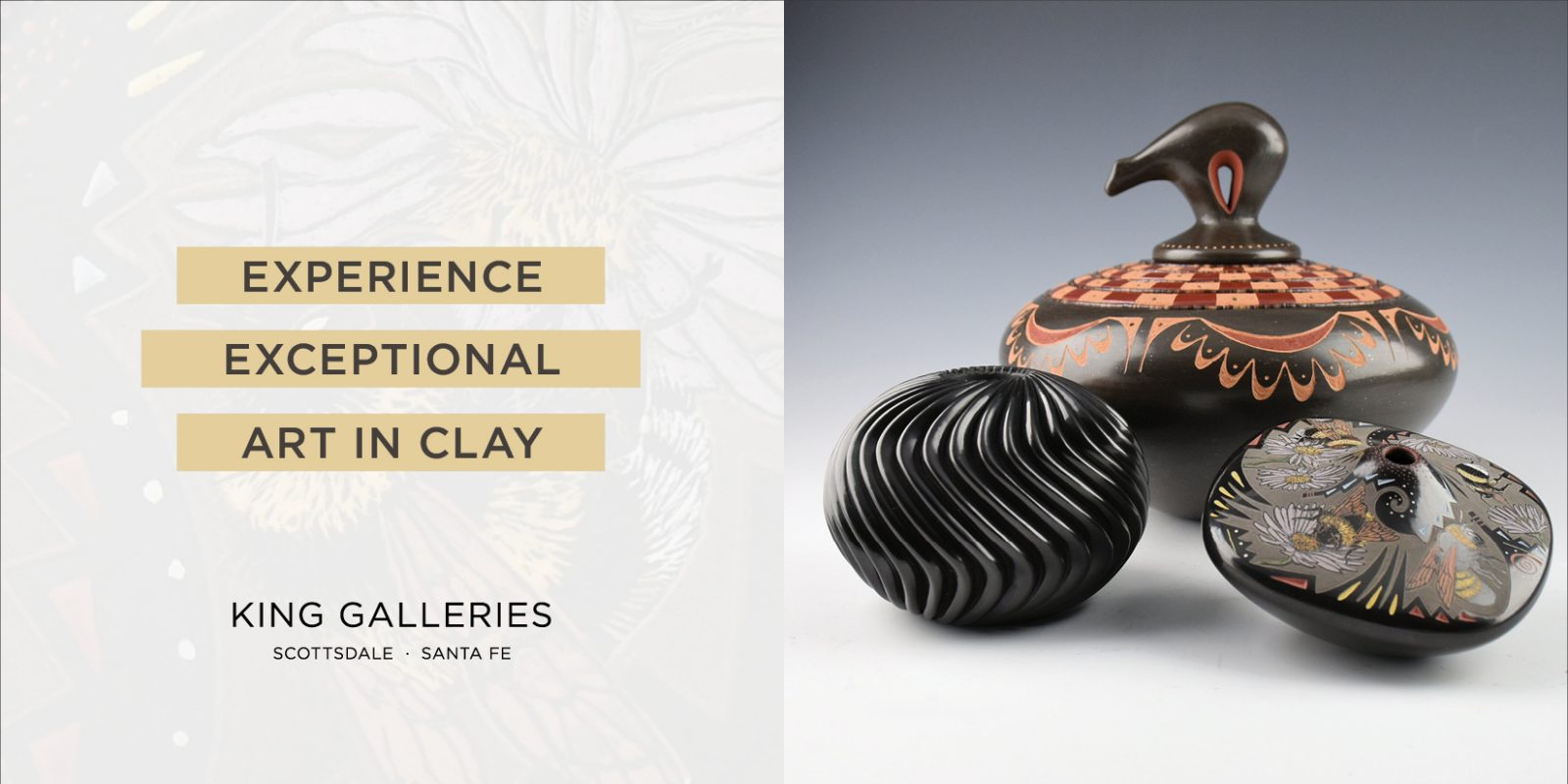Collector's Corner
COLLECTING FOR THE NEW MILLENNIUM
There have always been farsighted people who have recognized great artists and acquired their work long before it was sought after by the majority of collectors or exhibited in galleries and museums.
In the 1920s Gertrude Stein was buying up paintings by Picasso while he was still relatively unknown. Around the middle of the 20th Century Peggy Guggenheim and Gertrude Vanderbilt Whitney were busy purchasing Abstract Expressionist works. More recently, Herb Vogel, who worked as a clerk for the U.S. Postal service, and his wife Dorothy, a librarian, used their collecting acumen and limited funds to amass a collection of conceptual and minimalist works that was eventually valued in the millions. Each of these collectors saw what others had overlooked.
As a collector, it is my opinion that Native art will be to the 21st Century what mainstream American art was to the last century. It will be fully appreciated, avidly sought after by a diverse range of collectors, and prices will continue to soar.
More and more collectors, including those for whom Native art is not the main focus, have come to realize that Native art is important American art and that contemporary Native artists are producing some of the most vibrant, exciting, and thought provoking works being created today. Collectors are vying with each other to own important historic and contemporary Native works. This has created unprecedented competition for collectors who specialize in Native art.
Many collectors of mainstream art are no longer confining themselves to one medium or even to a particular art movement or period. They are more willing to be experimental than in the past and relish mixing Native art with the expected traditional choices. The most important thing for such collectors is that they love a particular work of art and that it reflects their wide-ranging tastes rather than match their décor. Many contemporary collectors have embraced an eclectic esthetic and have no problem displaying Native works in the same room as Impressionist and Abstract Expressionist paintings, Middle Eastern rugs, or Chinese ceramics. They want to shake things up and it works!
This new outlook has further emboldened American artists of Native origin to express their individuality through their art, to use new techniques, and to take inspiration from their own cultural traditions as well as from anything that motivates their creativity. For such innovative artists nothing is off limits.
Some Native artists have ventured into new artistic media such as glass. Ed Archie Noisecat, Marvin Oliver, and Preston Singletary, for example, create dazzling sculptures in the non-traditional medium of glass but derived from various aspects of Native culture.
Because of this Native art continues to command previously unheard of prices around the world. It is not unusual for major works sold at auction to far out pace pre-sale estimates and this trend shows no signs of slowing. However, what many people fail to realize is that, for the most part, Native art is quite affordable. True, some pieces sell for many thousands of dollars but savvy collectors know that important works can often be acquired for considerably less. It’s simply a matter of becoming knowledgeable.
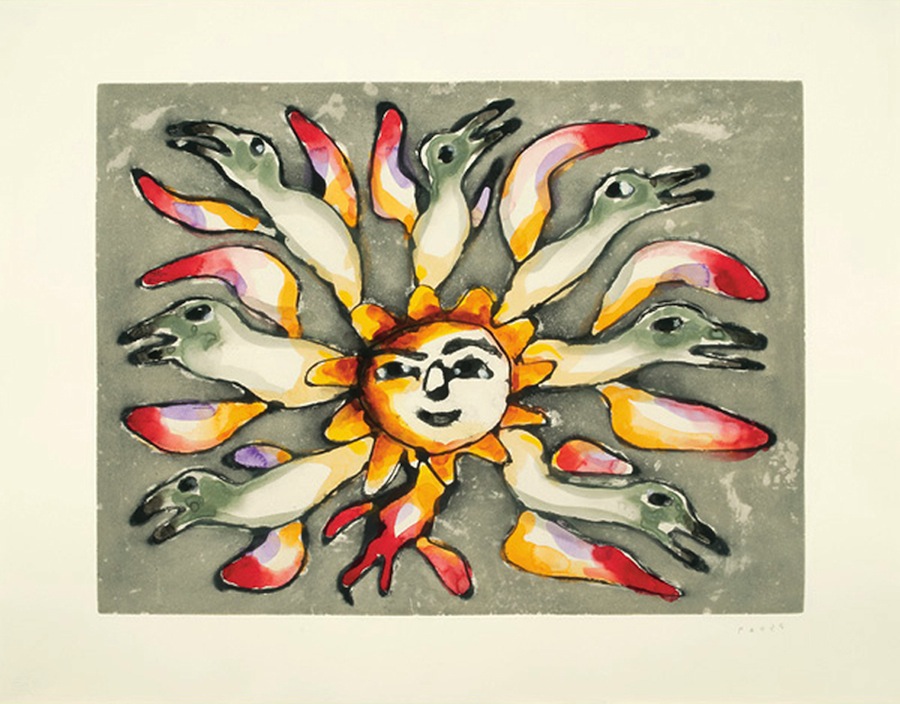
Collection of E. J. GuarinoSun Sister by Kenojuak Ashevak, etching, aquatint, sugar lift & hand painted on Arches paper, 20/50, Inuit, Cape Dorset, 31½”h x 40½”w, Cape Dorset Annual Print Collection # 11 (2011).
Inuit graphics are a good case in point. For example, drawings by Kenojuak Ashevak, one of Canada’s most famous contemporary artists, can be purchased for well under $2,000.00, while her prints sell for under $1,000.00 to over $2,500.00. Considering the artist’s celebrity, price points for her work are astonishingly affordable.
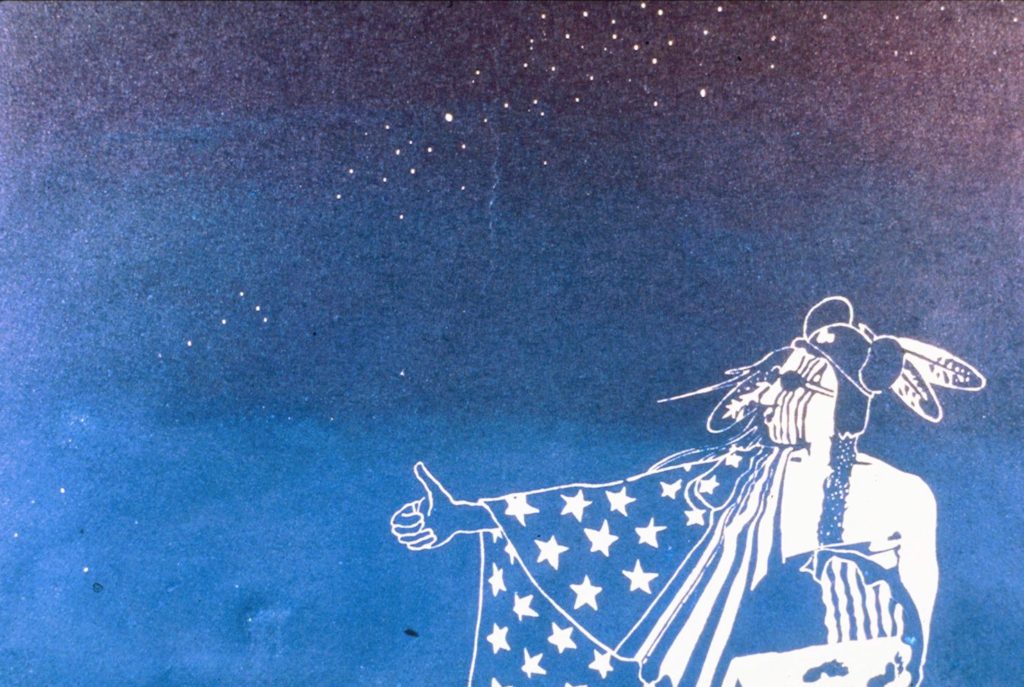
Native American Hitch-Hiker by Linley B. Logan, Seneca, woodblock relief print with oil based printing inks, 12”w x 8”h (1984). Photo courtesy of the artist.
Although he draws inspiration from a variety of sources, Linley B. Logan’s art is grounded in his Seneca culture. Logan’s work is richly symbolic, visually bold, yet accessible. So far, his art has not received the attention it justly deserves. Consequently, his work is extremely affordable. Astute collectors take note.
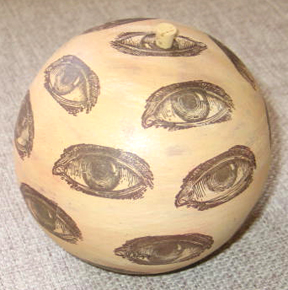
Eye See You, seed pot by Susan Folwell, Santa Clara Pueblo, 4“h x 17“ in diameter (2011). Collection of E. J. Guarino
Collectors have become more savvy, disregarding stale ideas of what constitutes fine art. The highly subjective line between “fine” art and craft has blurred and nowhere can this be seen more clearly than with the medium of pottery. The work of a number of Native ceramic artists is now exhibited in mainstream commercial galleries. Depending on the piece, work by established artists such as Susan Folwell, Jody Folwell, Diego Romero and Glen Nipshank generally sell for between $2,000.00 and $5,000.00 and, in some cases, for much less. Susan Folwell’s decidedly surreal Eye See You was acquired for $450.00.
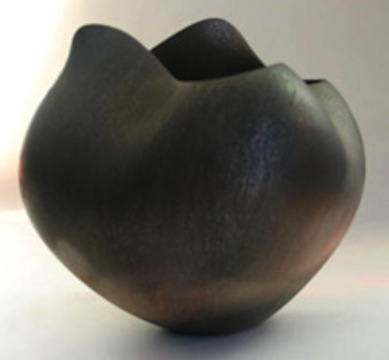
Asymmetrical micaceous pot with sgraffito markings and fireclouds by Glen Nipshank, Big Stone Cree, 6¼” at highest point x 9” at widest point (2007). Collection of E. J. Guarino
Considering the quality of his pieces and, in many cases, their size as well, the work of Glen Nipshank is astonishingly affordable. Nipshank explores form, color and shading in his ceramics, most of which are purposefully asymmetrical. Many collectors are surprised to learn that Mr. Nipshank is Native American because his art shatters stereotypical preconceptions of what constitutes Native ceramic art. This fact makes his art particularly attractive to those who do not necessarily specialize in collecting work produced by Native artists.

Transparency #6 by Rose B. Simpson, Santa Clara Pueblo, inlaid ceramic, tissue paper, 11” x 12” (2011). Collection of E. J. Guarino
Despite being young, Rose B. Simpson has already built a strong reputation for her imaginative, edgy work. Her inventiveness and willingness to take risks has brought her to the attention of a wide audience of collectors, many of whom do not generally collect the work of contemporary Native American artists. Ms. Simpson uses her art as a means of self-expression but also as a form of self-exploration. She works in a variety of media, producing sculptures, ceramics, drawings, prints, mixed media pieces, and performance art. Although her larger pieces often command many thousands of dollars, she also produces small scale works that are affordable.
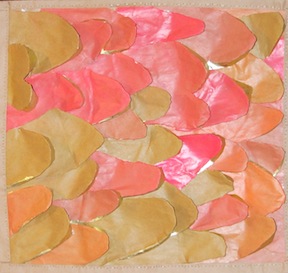
Feather by Eliza Naranjo Morse, Santa Clara Pueblo, “paper painting” made of paper, glue, sharpie, wood, thread, 18.5“ x 20.25“ (2011). Collection of E. J. Guarino
Relentless in pursuing her art, Eliza Naranjo Morse is fearless in her willingness to experiment with color, form, composition, and media. Perhaps best known for her works on paper, the artist sometimes references her extended family’s fame for ceramic art by incorporating clay in unexpected places such as a drawing. Thought provoking and bold, works by Eliza Naranjo Morse would be an important addition to any collection.
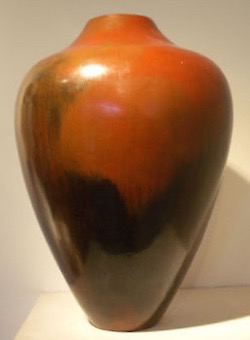
Pitch-coated red-brown vase with fire clouds by Alice Cling, Navajo (Diné), 11”h x 7½”w (c. 2002). Collection of E. J. Guarino
The work of Alice Cling, an artist who is credited with single-handedly taking Navajo pottery from folk art to fine art, is another good choice since currently most of her pieces sell for under $1,000.00. However, many believe that in the not too distant future her work will cost much more because she will be to Navajo pottery what Nampeyo, Maria Martinez, and Lucy Lewis are to Pueblo pottery.
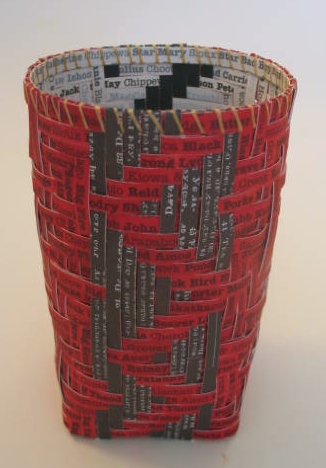

Unrestrainable by Shan Goshorn, Eastern Band Cherokee, Arches watercolor paper splints painted with archival inks, acrylic paint, 4.25” x 4” x 6” (2014). Collection of E. J. Guarino
When most people encounter Shan Goshorn’s work they assume that they are simply looking at benign baskets. It is only after a closer inspection that they realize that the artist has used a familiar form to ask profound questions about controversial social, political, spiritual and historical issues. The fact that Ms. Goshorn employs traditional basket making techniques with contemporary materials suggests that the many themes explored in her work are woven into the Native consciousness and are also, for good or ill, part of the fabric of American life. In the past few years, prices for Goshorn’s work have risen steadily and rightly so. Her baskets, which are in essence sculptures, have found favor not only with those who specialize in acquiring Native American works but also with collectors of contemporary art.
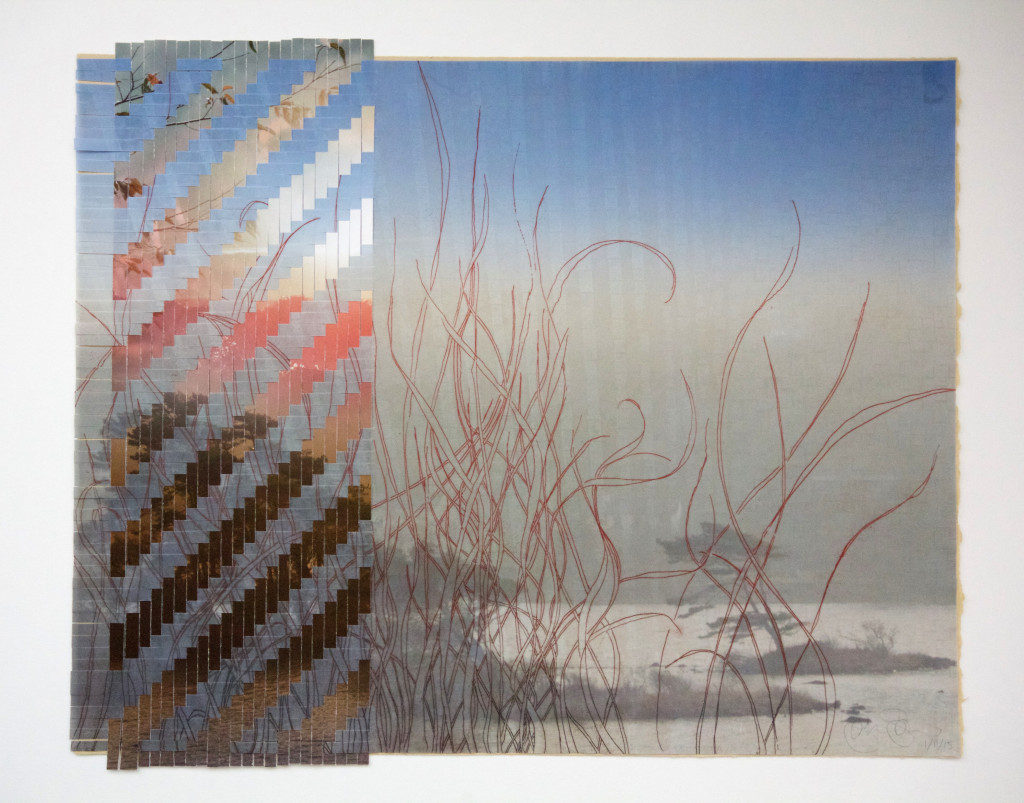
Collection of E. J. Guarino. Photo courtesy of the artist.…and the bamboo wove itself, by Sarah Sense, Chitimacha/Choctaw, colligraph, copper etching and digital print, 10/25, archival paper, archival ink, wax, tape, 15“ x 19“ (2015).
Like Shan Goshorn, Sarah Sense references traditional Native American weaving techniques in a decidedly contemporary way. Her assemblages combine contemporary materials and traditional Chitimacha weaving techniques. Employing woven photographs, Sense’s work often makes pointed social, historical and political commentary. Her work creates exquisite images while exploring concepts of light, form and color as the artist investigates themes such as media stereotyping of Native peoples, a sense of place, personal loss, elements such as water and earth, as well her own complex identity. Sense generally produces two dimensional works but recently created a unique group of contemporary baskets for the King Galleries of Scottsdale. Although Ms. Sense is fast gaining an international reputation as an important contemporary artist, much of her work can still be acquired for under $2,000.00. With a number of major gallery and museum exhibitions on both sides of the Atlantic to Sense’s credit, this may not be the case for much longer.
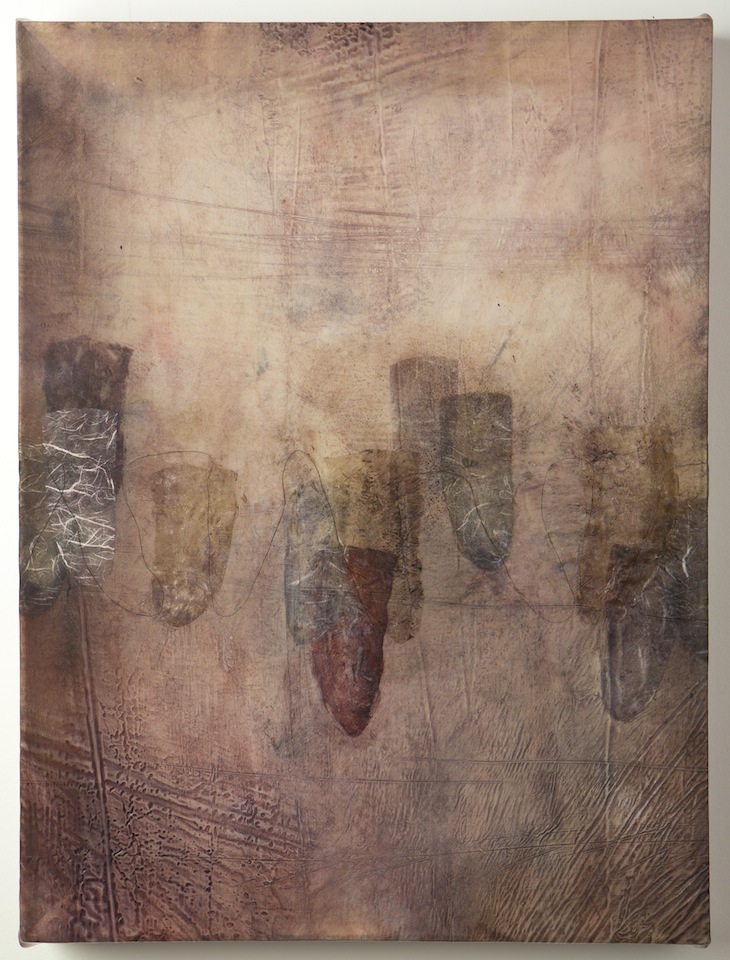
Plum Walrus Family Portrait by Sonya Kelliher-Combs, Inupiaq/Athabascan, acrylic polymer, thread, cellulose, 18”w x 24”h (2013). Collection of E. J. Guarino
Sonya Kelliher-Combs’ work is unlike that of any other contemporary artist. It brims with revelations, secrets, and metaphors. Perhaps most startling is the artist’s choice of materials such as walrus stomach, reindeer rawhide and fur, sheep intestine, seal skin, porcupine quills and human hair as well as industrial elements including metal grommets, thread, cotton fabric and polyurethane. The use of such unusual and expected media produces works that are mysterious, surreal, and strangely erotic. The found objects Kelliher-Combs employs are covered in thick layers of acrylic polymer or polyurethane, giving the appearance that they are imbedded in ice and frozen in time. Other pieces resemble stretched skin. Kelliher-Combs’ imagery is idiosyncratic and highly unusual. Although she draws inspiration from sources as diverse as geometric designs on ancient Inuit objects, historic scrimshaw, and Alaska Native clothing patterns, Kelliher-Combs’ work defies categorization and subverts our notions of what constitutes art and beauty. Prices for Ms. Kelliher-Combs range in price from as little as $100.00 to over $7,000.00.

Dead Indian Stories by Edgar Heap of Birds, Cheyenne, monoprints, all works in series 15” x 22” (2012). Photo courtesy of Radiator Gallery, Long Island City, NY.
In the minds of most, Conceptual art is not something they associate with Native American artists. The expectation for Native artists is the traditional arts – pottery, basketmaking, beadwork, weaving and such or a variation on these forms. Painting and printmaking might be considered but only in terms of representation and, perhaps, abstraction. However, more and more contemporary Native artists are refusing to be bound by such notions. Conceptualism stresses the importance of ideas over representation or imagery. It is intended to convey a concept. Using carefully chosen words, Edgar Heap of Birds creates works that are intellectually provocative and emotionally moving. Words have power and Mr. Heap of Birds’ art forces us to think, to make associations. Sometimes, at first glance, the words appear to have no connection but they stay in the viewer’s consciousness colliding off one another, revealing meaning. Heap of Birds’ combinations have been compared to haiku because they have a poetic quality. Nonetheless, the artist’s association of words may make his audience uneasy while it considers the nature of language. Despite being exhibited nationally as well as internationally, prices for much of Edgar Heap of Birds’ work is affordable. Individual works from his Dead Indian Stories series, for example, are available for $2,000.00
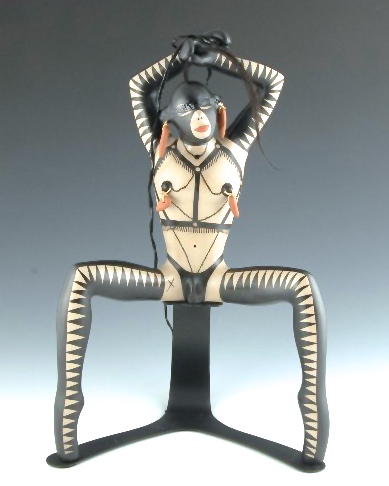
Seated figure by Virgil Ortiz, Cochiti, 10”w x 15”h (2009). Collection of E. J. Guarino
Virgil Ortiz epitomizes the changing attitudes of collectors and museums. Not only is his work represented in galleries that specialize in art created by Native artists but also in mainstream galleries. This is due in large part to the artist’s refusal to be easily categorized. Although he is most noted for his ceramic creations, Mr. Ortiz has collaborated with New York fashion icon Donna Karan, produced his own fashion line, a jewelry collection and a carpet and pillow collection. Ortiz works in a variety of other media as well such as print making, film and video. However, some of his most sought after and controversial works are his ceramic figures, which are a tour de force that fearlessly challenge the limits of the ceramic medium. Many of the figures twist in astonishing ways, which is a striking achievement in the art of ceramics. Ortiz’ figures are full of movement and drama as only he can elicit from clay. Ceramic works by Virgil Ortiz range from $2,000.00 to well over $7,000.00 and prices will continue to rise as a wide range of collectors compete to acquire his work.
Although it is never a good idea to buy art solely for investment purposes, it is, nonetheless, necessary to keep in mind that a collection is an important part of one’s financial portfolio and, as such, should be managed as carefully as any other asset. Because of the vagaries of the art market, the price points for Native art are decidedly less than they should be. This will not be the case for much longer. For example, in 1997 I added two drawings by Inuit artist Janet Kigusiuq to my collection for $450.00 each. Over the years, prices for Kigusiuq’s work has risen steadily and the artist’s drawings now sell for over $3,000.00. A few years ago a gallery owner in Albuquerque said to me, “What many collectors don’t realize is that now is the time to buy more Native art, not less.” It is sound advice. As perceptions broaden as to what constitutes American art, the work of Native artists will continue to be collected and appreciated by an ever-widening audience.
